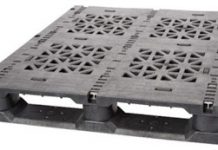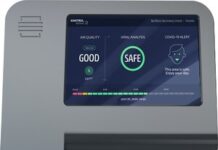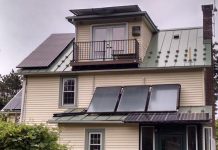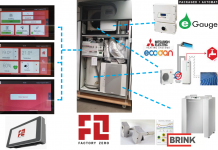 I highlighted FLIR Systems (NASD:FLIR) as a way to participate in the growth of the energy auditing industry in late 2007. I was ambivalent about it at the time: I very much liked the potential growth story, but felt the stock was overvalued.
I highlighted FLIR Systems (NASD:FLIR) as a way to participate in the growth of the energy auditing industry in late 2007. I was ambivalent about it at the time: I very much liked the potential growth story, but felt the stock was overvalued.
Flir has fallen about 35% since late 2007, and 50% since its peak in July 2008 (while revenues have grown about 50%), prompting me to give it another look.

Infrared Stimulus
Weatherization of low income housing and Federal building retrofits are a major component of the American Recovery and Reinvestment Act (aka "Stimulus Package.") This will require the hiring and training of thousands of new energy auditors, for whom infrared (IR) imaging is an extremely versatile tool, both in terms of finding out what problems need to be fixed, and for convincing the customer that they are necessary. IR imaging is not necessary for an effective energy audit, but it is increasingly becoming part of the energy auditor’s standard kit. I expect that new energy auditors are likely to flock to the technology because of its strong visual appeal. In addition, it requires training to use IR cameras properly, a service which Flir also provides.
Because an IR audit is cheaper than a full energy audit, some state weatherization programs or utility Demand Side Management programs will choose to to adopt IR audits as the sole energy audit used in their program. I think that this is likely, because Xcel Energy (XEL) initially proposed the use of IR audits in their most recent Demand Side Management Plan last fall. Although, due to the efforts of the Energy Efficiency Business Coalition (EEBC), for whom I was consulting at the time, the final plan used the considerably more robust HERS audits. If EEBC had not intervened, the plan almost certainly would have been approved with infrared audits as the sole requirement, which is why I expect that result in some of the many other national programs starting as the result of the Stimulus package. In cases where IR are not the sole requirement, properly used IR cameras are extremely useful tools in the energy auditor’s kit, increasing both the speed and accuracy in detecting problems, so are likly to have some role in all such programs.
Flir’s equipment is also used in maintenance and diagnostics of a large range of commercial equipment. Much like rail maintenance stock Portec (PRPX), while manufactures are delaying new investment, such delays may increase the demand for Flir’s imaging equipment to help assure that older equipment continues to function efficiently. For instance, their GasFindIR range of cameras is designed to detect leaks of organic gasses, such as methane. While stopping leaks is valuable in its own right, the potency of methane as a greenhouse gas means that a greenhouse gas cap and trade legislation will likely provide additional incentives to detect and fix gas leaks.
Growth Story
FLIR Systems is a growth story based on the rapidly decreasing price of thermal imaging systems, which leads to a rapidly growing market quickly expanding to new applications. So far, the financial crisis has done little to reduce sales growth, and margins remain extremely robust, with a net operating margin of 26% and a return on equity of 28%, both of which have been increasing even with decreasing minor use of financial leverage.
While the stock price was plunging along with the market, revenue continued to grow at a robust 38% from FY 2007 to FY 2008, and the strength continued in the final quarter of 2008. Management expects revenue to continue to grow at a more subdued 11-16% in 2009, without assuming any improvements in global economic conditions. They have a low debt-to equity ratio of 0.23 which fell in 2008 and FLIR has continued to lower debt this year by allowing holders of its senior convertible notes to exchange them for equity. Even with this declining leverage, their financial statements show no sign of difficulty in collecting payments from customers.
With the stock at $21, the P/E ratio is now down to 17, about half of what it was when I first looked at the company. I recently sold puts to acquire shares if the price falls below $15.
The Other 70%
Flir is not a pure-play energy efficiency stock. According to the most recent annual report, the Thermography division, which includes the energy efficiency applications discussed above, accounted for approximately 30% of revenues in 2008, while its Commercial Vision Systems unit accounted for 17% and its Government Systems unit for 53%.
Its Government Systems unit supplies military, police, and paramilitary with advanced infrared imaging equipment. While defense stocks as a whole may not be a safe have in this recession, some analysts see FLIR’s military supplier role as an advantage, because they expect government spending on small ticket items (as opposed to tanks and fighter jets) to remain robust. Since I’ve never analyzed this sector, I can’t take a strong position on this, but imaging systems seem to be military hardware which make a lot of sense in our current wars in Iraq and Afghanistan.
When considering an investment in Flir, it’s important to understand that the company’s primary markets are military and security, and they are likely to remain so, as all divisions are on robust growth trajectories. Many clean energy investors may be uncomfortable with military contracting from a moral standpoint, but I feel that sensing systems are as likely to save civilian lives as they are to end them.
From a financial analysis standpoint, I simply know that I don’t understand the industry. I can say, however, that this segment seems the safest part of the company’s business, largely because they have a large an growing backlog in the segment. One other upside is the fact that Flir is lumped with other military contractors and few other alternative energy investors are looking at the company. Most of the analysts who follow it specialize in military contractors… such analysts are therefore as unlikely to understand the true potential of the energy efficiency market as we are to understand the potential of the military market.
Tom Konrad,
Ph.D.
DISCLOSURE: Tom Konrad has a long position in FLIR.
DISCLAIMER: The information and trades provided here and in the comments are for informational purposes only and are not a solicitation to buy or sell any of these securities. Investing involves substantial risk and you should evaluate your own risk levels before you make any investment. Past results are not an indication of future performance. Please take the time to read the full disclaimer here.









As the street price of thermal cameras declines, I expect to see the profit margins of specialized premium thermal camera companies such as Flir to drop as well. Multiple firms, including L-3 have been promising breakthroughs in uncooled microbolometer costs for years. Someday they will make good on these promises.
Thanks for the thought Keven. That certainly seems to be the greatest long term risk factor for FLIR.
The question has to be, will FLIR’s uncooled cameras (the sell both at a broad range of price points) continue to retain market share, so that they can maintain profitability even as margins decline?